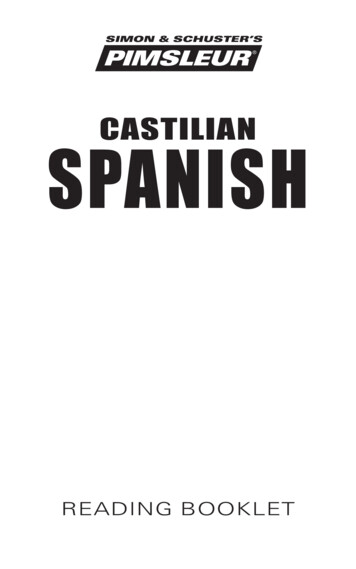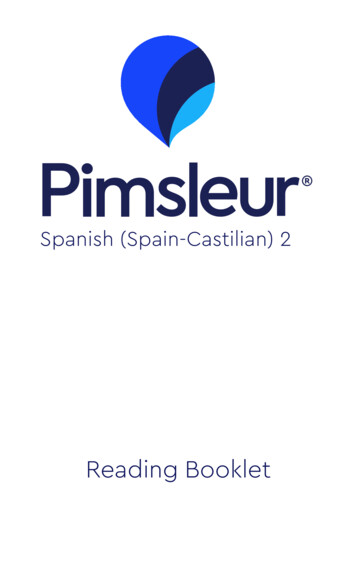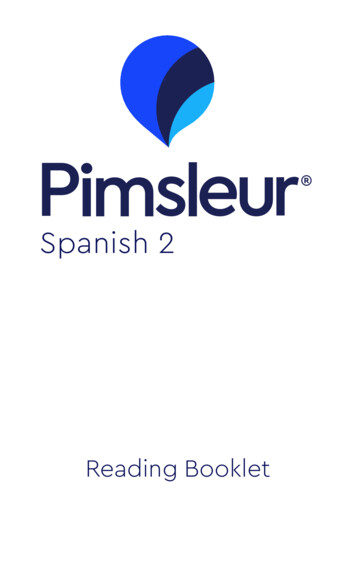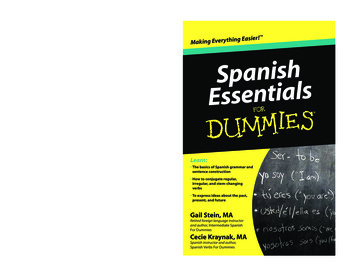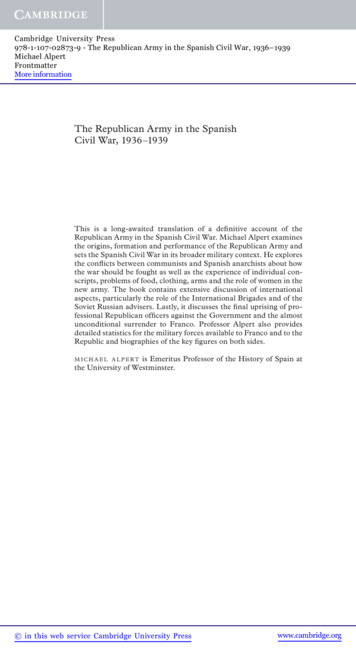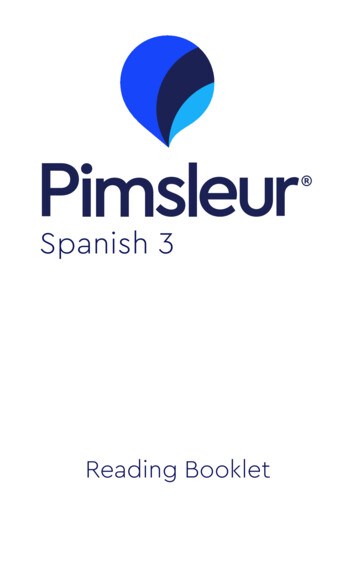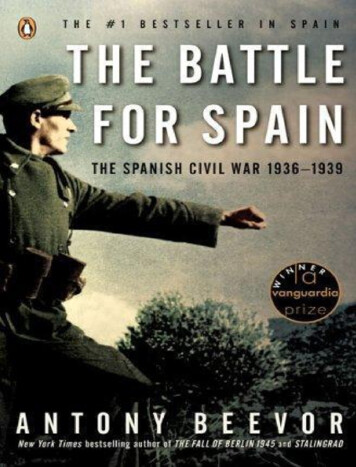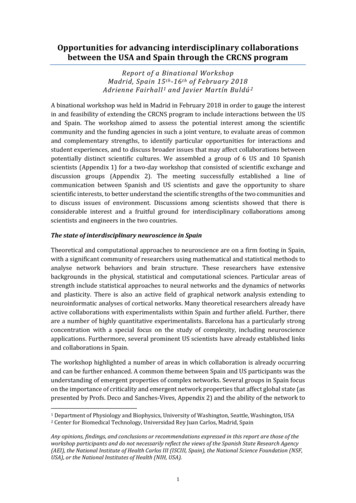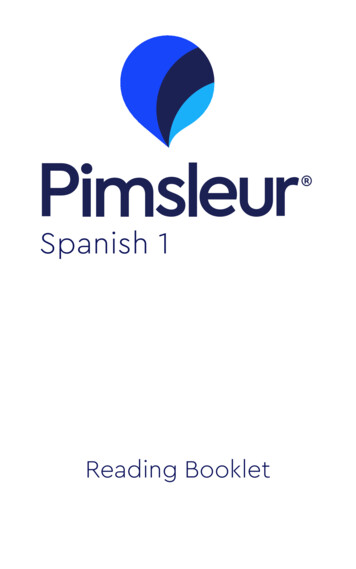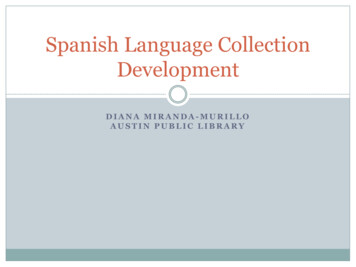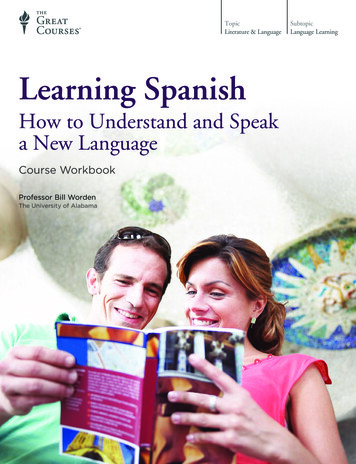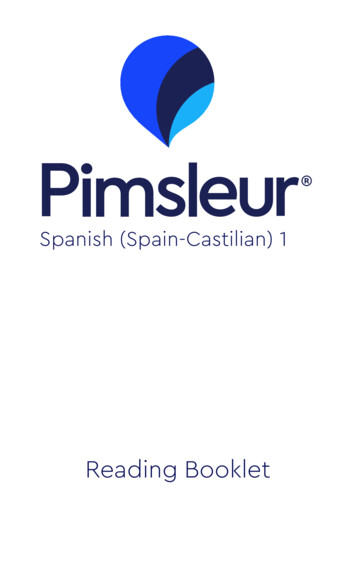
Transcription
Spanish (Spain-Castilian) 1Reading Booklet
Spanish (Spain-Castilian) 1Travelers should always check withtheir nation's state department forcurrent advisories on local conditionsbefore traveling abroad.Booklet Design: Maia Kennedy and ‰ Recorded Program 2012 Simon & Schuster, Inc. Reading Booklet 2012 Simon & Schuster, Inc.Pimsleur is an imprint of Simon & Schuster Audio,a division of Simon & Schuster, Inc. Mfg. in USA.All rights reserved.ii
Spanish (Spain-Castilian) 1ACKNOWLEDGMENTSVoicesEnglish-Speaking Instructor . . . . . . . . . . . Ray BrownSpanish-Speaking Instructor . . . . . . . . . . . Alvaro RuizFemale Spanish Speaker . . . . . . . . . . . Marta VelascoMale Spanish Speaker . . . . . . . . . Ramsés V. MartinezCourse WritersJaime Mauricio Fatás Cabeza Joan SchoellnerEditor & Executive ProducerBeverly D. HeinleProducer & DirectorSarah H. McInnisRecording EngineersPeter S. Turpin Kelly SauxSimon & Schuster Studios, Concord, MAiii
Spanish (Spain-Castilian) 1Table of ContentsIntroductionThe Spanish Language . . . . . . . . . . . . . . . . . . . 1Castilian Spanish . . . . . . . . . . . . . . . . . . . . . . . . 4The Spanish Alphabet . . . . . . . . . . . . . . . . . . . . 5Readings . . . . . . . . . . . . . . . . . . . . . . . . . . . . . . 6Lesson Eleven . . . . . . . . . . . . . . . . . . . . . . . . . . . . . 8Lesson Twelve . . . . . . . . . . . . . . . . . . . . . . . . . . . . 9Lesson Thirteen . . . . . . . . . . . . . . . . . . . . . . . . . . . 10Lesson Fourteen . . . . . . . . . . . . . . . . . . . . . . . . . . . 11Lesson Fifteen . . . . . . . . . . . . . . . . . . . . . . . . . . . . . 12Lesson Sixteen . . . . . . . . . . . . . . . . . . . . . . . . . . . . 13Lesson Seventeen . . . . . . . . . . . . . . . . . . . . . . . . . . 14Lesson Eighteen . . . . . . . . . . . . . . . . . . . . . . . . . . . 15Lesson Nineteen . . . . . . . . . . . . . . . . . . . . . . . . . . . 16Lesson Twenty . . . . . . . . . . . . . . . . . . . . . . . . . . . . 17Lesson Twenty-One . . . . . . . . . . . . . . . . . . . . . . . . 18Lesson Twenty-Two . . . . . . . . . . . . . . . . . . . . . . . . 19Lesson Twenty-Three . . . . . . . . . . . . . . . . . . . . . . . 20Lesson Twenty-Four . . . . . . . . . . . . . . . . . . . . . . . . 21Lesson Twenty-Five . . . . . . . . . . . . . . . . . . . . . . . . 22Lesson Twenty-Six . . . . . . . . . . . . . . . . . . . . . . . . . 23Lesson Twenty-Seven. . . . . . . . . . . . . . . . . . . . . . . 24Lesson Twenty-Eight . . . . . . . . . . . . . . . . . . . . . . . 25Lesson Twenty-Nine . . . . . . . . . . . . . . . . . . . . . . . . 26Lesson Thirty. . . . . . . . . . . . . . . . . . . . . . . . . . . . . . 27iv
Spanish (Spain-Castilian) 1The Spanish LanguageSpanish is the most widely spoken of theRomance languages, which are a Latin branch ofthe Indo-European language group. This branchincludes French, Italian, Portuguese, and Romanian,among others. Spoken primarily in Central andSouth America and in Spain --- and by a sizeableand fast-growing population of speakers in theU.S. --- Spanish is the first language of more than350 million people, more than any other languageexcept Mandarin Chinese. It’s the official languageof twenty-one countries and is one of the six officiallanguages of the United Nations. Furthermore,Spanish is a common second language --- the moststudied after English, and the third most commonlyused on the Internet after English and Mandarin.The language can be called either “Spanish”or “Castilian.” Both terms are correct, althoughpolitical issues or local custom may dictate whichis used. The name “Castilian” derives from theKingdom of Castile (meaning “Land of Castles”),one of several kingdoms that spread across theIberian peninsula during the Middle Ages. The term“Spanish” is a more recent one that first referredto Spain as a country and was later applied to itspredominant language as well.
Spanish (Spain-Castilian) 1Modern Spanish/Castilian evolved from severaldialects of Latin that were spoken in north-centralIberia during the 8th or 9th century. During thisearly period it was influenced by local languagessuch as Basque. Eventually it spread into thesurrounding area, particularly the south, whereit was further influenced by Arabic. In the 13thcentury, King Alfonso X (known as “Alfonso theWise”) was the first king to use Castilian extensively.He also began to standardize it byassembling court scribes and supervising theirwriting— in Castilian — on works of history, law,astronomy, and other fields, thereby establishingCastilian as a language of higher learning.In the 15th century, Old Castilian, or Old Spanish,began to evolve into what is now Modern Spanish— the difference being mainly one of pronunciation(the devoicing and shifting of sibilant consonants).Someone who can read Modern Spanish can learnto read Old Spanish with very little difficulty. Thedifference is much less stark than between OldEnglish and Modern English.Beginning at the end of the 15th century, theexpansion of the Spanish Empire took Spanishbeyond Spain’s borders — to Central Europe, the2
Spanish (Spain-Castilian) 1Americas, parts of Africa, and several island groupsin the Pacific, among other locations. It becamean important language for government and trade.In Africa, Spanish is now the official language ofonly Equatorial Guinea, and it is no longer spokenby many people in the Pacific. In the Americas,however, the descendants of the original Spaniardscontinued to use Spanish; and in the 19th century,as the colonies overthrew Spanish rule, the newleaders encouraged the population to becomefluent in Spanish in order to strengthen nationalunity. Today it’s the official language of most of theSouth American countries.In addition to Spanish, Spain has three otherofficially recognized languages: Catalan, Galician,and Euskara (Basque). The country also hostsseveral regional dialects. In fact, about a fourthof the country’s residents use a tongue other thanSpanish as their first language. Language identityand use continue to be pressing political issues inparts of the country.3
Spanish (Spain-Castilian) 1Castilian SpanishIn the United States, the term “Castilian” or“Castilian Spanish” usually refers to the dialect thatis the official language of Spain, where it’s used intelevision and radio broadcasts. It is understoodthroughout the country, although there are markedregional differences.The difference between Castilian Spanish asspoken in Spain and Spanish as spoken in theAmericas (now called Latin American Spanish) isdue to the diminishing contact between Spainand the Americas over the centuries and to theinfluence of local languages in the Americas. Thesetwo main variants of Spanish are mutually intelligible; the difference between them is comparableto that between British English and AmericanEnglish. The main difference is one of pronunciation —most notably of the “c” and “z” before an“i” or “e,” which are pronounced as “s” in Centraland South America and as “th” in Spain. (Thereis a story that this “th” pronunciation is becauseone of the Spanish kings had a lisp. The story isjust that — a story. The pronunciation is the resultof the natural evolution of the language.) Inaddition, there are slight grammatical differences,and certain words have regional differences inmeanings or alternate genders assigned to them.4
Spanish (Spain-Castilian) 1Pimsleur’s Spanish (Spain-Castilian) 1 teachesthe official dialect as spoken by the majority ofSpanish-speakers in Spain.The Spanish AlphabetThe Spanish alphabet once had thirty letters.In addition to the twenty-six letters of the Englishalphabet, “ch,” “ll,” “rr,” and “ñ” were consideredseparate letters. After a revision by the SpanishRoyal Academy in the 1990s, only the “ñ” remains —for a total of twenty-seven letters. However, somedictionaries and some Latin American countriesstill use the old system. In this system, wordsbeginning with “ch” follow those beginning with“cz.” Similarly, “ll” follows “lz” and “rr” follows “rz.”Unlike English, Spanish pronunciation of theletters and letter combinations is very consistent.Once you know the basic guidelines, you will beable to read Spanish easily.5
Spanish (Spain-Castilian) 1ReadingsAfter an initial introduction to the spokenlanguage, reading is integrated into the programstarting with Lesson Eleven. In these ReadingLessons you will learn to sound out the Spanishalphabet, starting with short words, thenprogressing to longer words, word combinations,and short phrases, increasingly building in lengthuntil you will be reading complete sentences incontext. The Spanish alphabet is systematicallyintroduced and you will learn to associate eachletter with the sounds of Castilian Spanish. You willnot, at first, be reading for meaning, but rather forsound/symbol correlation. Eventually, when thesound system is mastered, you will be able to lookat known vocabulary and read for meaning. By theend of the course, you will be reading at the samelevel as you are speaking.The reading items in the lessons have beenselected especially to give you practice in theunique Spanish sounds and sound combinations. Your vocabulary acquisition will begin afteryou’ve learned the new, different sound system.You should read aloud, as directed. The processof saying the words out loud will reinforce andenhance your Spanish language acquisition and willhelp lodge the sounds of Spanish in your memory.6
Spanish (Spain-Castilian) 1In these Reading Lessons, you will learn to look atthe Spanish alphabet with Spanish eyes.There are twenty Spanish Reading Lessons,which start at the end of Lesson Eleven. Theselessons are also combined and provided at theend of the course. You may choose to do theReadings along with the lessons, or you may waituntil you have completed the course and do themall together. Repeat the Reading Lessons as oftenas you wish. Instructions on how to proceed withthe Readings are contained in the audio.7
Spanish (Spain-Castilian) 1Lesson be14.tenemos15.hablo16.hasta17.hora18.llamo19.Me llamo Carlos.20.Soy de Sevilla.8
Spanish (Spain-Castilian) 1Lesson a7.por favor8.el papel9.calor10.vamos11.el señor12.baño13.comer14.ellos15.la niña16.comprar17.entender18.avenida19.Hablo un poco de español.20.Habla muy bien, señor.9
Spanish (Spain-Castilian) 1Lesson Thirteen1.Norteamérica2.¿Es usted de Norteamérica?3.Ud.4.Sí, soy norteamericana.5.Hablo inglés.6.entiendo7.¿Entiende?8.¿Entiende bocadillo14.bañar15.lloro16.No importa.17.¿Cómo está usted, señorita?18.Estamos en Madrid.19.Está bien.20.Adiós.10
Spanish (Spain-Castilian) 1Lesson Fourteen1.año2.las horas3.el año4.la tarde5.paella6.bueno7.Buenas noches.8.grande9.casa10.la casa grande11.hambre12.hombre13.dos lo19.¿Puede comer pollo?20.¿Por qué no?11
Spanish (Spain-Castilian) 1Lesson tá7.esta8.aquí9.¿Está allí?10.No está allí, señora.11.habrá12.quedo13.quien14.No tengo dólares.15.¿Dónde está el Hotel La Plata?16.Está a dos calles de aquí.17.¿Es caro?18.Creo que no.19.¿Qué le ha dicho?20.No me ha dicho nada.12
Spanish (Spain-Castilian) 1Lesson Sixteen1.Buenos días.2.muchacho3.mañana4.No quiero.5.¡Es estupendo!6.gente7.gitano8.un gran gitano9.gerente10.lejos11.Juan12.Jorge13.Tengo un gato.14.la geografía15.gracias16.señor García17.en el centro18.José es mi hermano.19.Vive en Barcelona.20.No sabe conducir.13
Spanish (Spain-Castilian) 1Lesson Seventeen1.Esa mujer .2.tiene muchos niños.3.¿Quieres beber algo?4.Hoy es jueves.5.Ese caballero .6.es mi sobrino.7.Es el número cinco.8.azul9.En el mes de septiembre .10.empieza el otoño.11.Estoy en la cocina.12.Es un gigante.13.jugar14.No quiero jugar.15.el mes de marzo16.dos cervezas17.la página18.el guiso19.la guerra20.¡Qué horror!14
Spanish (Spain-Castilian) 1Lesson Eighteen1.correspondencia2.el cielo cubierto3.pague4.llegue5.Llegó a las diez.6.¿Hay tiempo?7.Busco la Plaza Mayor.8.Quiero agua fría.9.Es una zona comercial.10.Cuidado con el perro.11.La señora me llama.12.Necesito alquilar un coche.13.Toca la guitarra.14.enseguida15.Quizá llueva mañana.16.¡Me hace daño!17.¿De dónde es el señor Aguilar?18.Es de Guatemala.19.¿Va a tomar un café?20.No, prefiero un té.15
Spanish (Spain-Castilian) 1Lesson Nineteen1.buscar2.vino blanco3.vivido / bebido4.Me gusta viajar en barco.5.Los bandidos se van.6.¿Quién va a pagar?7.según el libro8.saco / saque9.la cuenta10.nueve / jueves11.llueve12.el pájaro13.Julio lo dijo.14.¡Qué sonrisa!15.No creo que lleguen.16.Voy a beber tres cervezas .17.en cuatro minutos.18.¿Conoce a Jorge?19.Sí, le conozco.20.Pero no sé dónde está.16
Spanish (Spain-Castilian) 1Lesson Twenty1.la ley2.seguir3.No hay nada.4.¿Qué hay allí?5.Hay muchas cosas.6.Vamos a comer ahora.7.Apáguela.8.Apague la luz.9.A las cuatro menos cuarto.10.el número dieciséis11.¡Hola, José!12.Dígame, ¿qué hora es?13.Ahora son las doce.14.No entiendo muy bien.15.¿Dónde está su esposa?16.Mi esposa está en Francia.17.Su nieta vive en París.18.¿De veras?19.Quisiera pedir un vino.20.Gracias por ayudarme.17
Spanish (Spain-Castilian) 1Lesson Twenty-One1.¿Qué va a beber?2.Voy a tomar un zumo de naranja.3.Puedo beberlo, pero no puedo pagarlo.4.Hoy no tengo dinero.5.Yo tengo muchos euros.6.veinticinco7.treinta y ocho8.cuarenta y nueve9.¿Vais a comprar un recuerdo de España?10.Nosotros no lo sabemos.11.No sabemos qué vamos a comprar.12.Pero queremos comprar algo.13.Porque tenemos euros .14.y tarjeta de crédito.15.¡Qué noche más bella!16.Al día siguiente .17.llegué a Los Ángeles.18.Siga por allí.19.¿Cuánto tiempo para llegar?20.Desafortunadamente, no lo sé.18
Spanish (Spa
4 Spanish (Spain-Castilian) 1 In the United States, the term “Castilian” or “Castilian Spanish” usually refers to the dialect that is the official language of Spain, where it’s used in television and radio broadcasts. It is understood throughout the country, although there are marked regional differences. The difference between Castilian Spanish as spoken in Spain and Spanish as .
